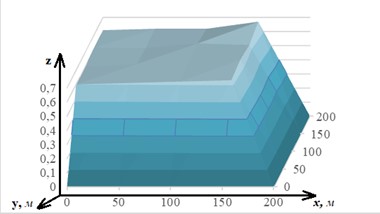Virtual Cloud Density Calculation Based on Fourier Transform
Main Article Content
Abstract
The task was to verify the theoretical material by introducing existing data and modeling the actual operating conditions of solar panels.
Depending on the ratio of the linear velocity of clouds and the speed of the Sun, which is determined by its angular motion, the following three cases are possible:
the linear velocity of the cloud is much greater than the speed of the Sun, which is determined by its angular movement. Then, at some observation interval, the position of the Sun is assumed to be fixed, while the clouds and their projections move some distance;
the linear velocity of the cloud is much less than the speed of the Sun, which is determined by its angular movement;
the linear velocity of clouds and the speed of the Sun, which is determined by its angular movement, are values of the same order.
The article considers the first case when the speed of a cloud is much higher than the speed of the Sun.
To simplify the calculations, we assume that the cloud projection is a circle with some radius, although the developed mathematical model allows calculations for clouds of any shape and size. Fixation of the decrease in the magnitude of the intensity of solar radiation is determined by the light sensors installed in a checkerboard pattern with some step.
When calculating the virtual density of the cloud, we present the cloud as a filter and solar radiation passes through it. The first step to determine the density of the cloud will be to determine the image of the function of the change in the intensity of solar radiation. This is possible due to the direct discrete Fourier transform. After some transformations we will receive an expression from which it is possible to define the image of function of change of density of a cloud. For the function of the intensity of solar radiation, we choose a fixed value. This is due to the small period of time in which the density of the cloud is determined. The next task is to find the original function of the cloud density change. This is the purpose of all calculations. The inverse Fourier transform was used for the calculations. At last we could see the 3D model of the virtual density of the cloud according to the area of its projection on the sensor of a solar power plant. It is shown in a different shade of color every 10% of the density. Solar radiation intensity data obtained every minute from sensors located in Zagreb, Croatia are used for calculations.
The proposed technique allows using the inverse discrete Fourier transform method to determine the virtual density of the cloud according to the magnitude of solar radiation falling on solar panels, and extrapolate the obtained values to predict the amount of energy at the output of a solar power plant.
Article Details

This work is licensed under a Creative Commons Attribution 4.0 International License.
Authors who publish with this journal agree to the following terms:- Authors retain copyright and grant the journal right of first publication with the work simultaneously licensed under a Creative Commons Attribution License that allows others to share the work with an acknowledgement of the work's authorship and initial publication in this journal.
- Authors are able to enter into separate, additional contractual arrangements for the non-exclusive distribution of the journal's published version of the work (e.g., post it to an institutional repository or publish it in a book), with an acknowledgement of its initial publication in this journal.
- Authors are permitted and encouraged to post their work online (e.g., in institutional repositories or on their website) prior to and during the submission process, as it can lead to productive exchanges, as well as earlier and greater citation of published work (See The Effect of Open Access).
References
"Rozvytok vidnovlyuvanyh dzherel enerhiyi v Ukrayini [Development of renewable energy sources in Ukraine]," [Online]. Available: http://energymagazine.com.ua/wpcontent/uploads/2017/03/Rozvitok-VDE-v-Ukraini.pdf. [Accessed 07 february 2019].
V. J. Zhuikov, L. M. Lukianenko, D. A. Mykolaiets, K. S. Osypenko, A. O. Steliuk, T. O. Tereshchenko and J. S. Yamnenko, Pidvyshchennya efektyvnosti system z vidnovlyuvanymy dzherelamy enerhiyi [Increasing the efficiency of systems with renewable energy sources], Kyiv: Igor Sikorsky KPI, 2018, p. 365.
B. Zhalnin, M. Kagan and A. Naumov, "Vidchiznyana kosmichna energetika: vchora, sogodni, zavtra [Domestic space energy: yesterday, today, tomorrow]," Electronics Science Technology Business, vol. 2, 2016.
K. S. Osypenko, "Vyznachennya virtualnoyi shchilnosti khmar iz zastosuvannyam metodu zvorotnoho peretvorennya [Determination of virtual density of clouds with the use of the method of inverse transformation]," Electronics and communication, vol. 22, no. 3 (98), pp. 55 - 60, 2017. DOI: 10.20535/2312-1807.2017.22.3.103844
D. N. Karamov, "Matematicheskoe modelirovanie solnechnoy radiatsii s ispolzovaniem mnogoletnih meteorologicheskih ryadov, nahodyaschihsya v otkryitom dostupe," Bulletin of the Tomsk Polytechnic University. Geo Аssets Engineering, vol. 328, no. 6, pp. 28 - 37, 2017.
Pyrometer, "Wikipedia," [Online]. Available: https://en.wikipedia.org/wiki/Pyrometer. [Accessed 17 April 2020].
O. G. Zbronskyi, Modeling the virtual density of clouds, Kyiv, 2020, p. 75.
R. J. Marks II, Handbook of Fourier Analysis & Its Applications, Oxford: Oxford University Press, 2009, p. 744. ISBN: 978-0195335927
"Laboratory for Renewable Energy Systems (LARES) of University of Zagreb, Faculty of Electrical Engineering and Computing," [Online]. Available: https://www.lares.fer.hr. [Accessed 19 May 2019].
M. I. Stadnyk, O. O. Rubanenko and S. V. Bondarenko, "Viznachennya rivnya generatsiyi elektroenergiyi na sonyachniy elektrostantsiyi vIdnosno yiyi vstanovlenoyi potuzhnosti [Determining the level of electricity generation at a solar power plant relative to its installed capacity]," Technology, energy, transport agro-industrial complex, no. 3 (95), pp. 213 - 220, 2016.





